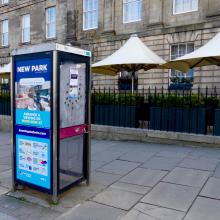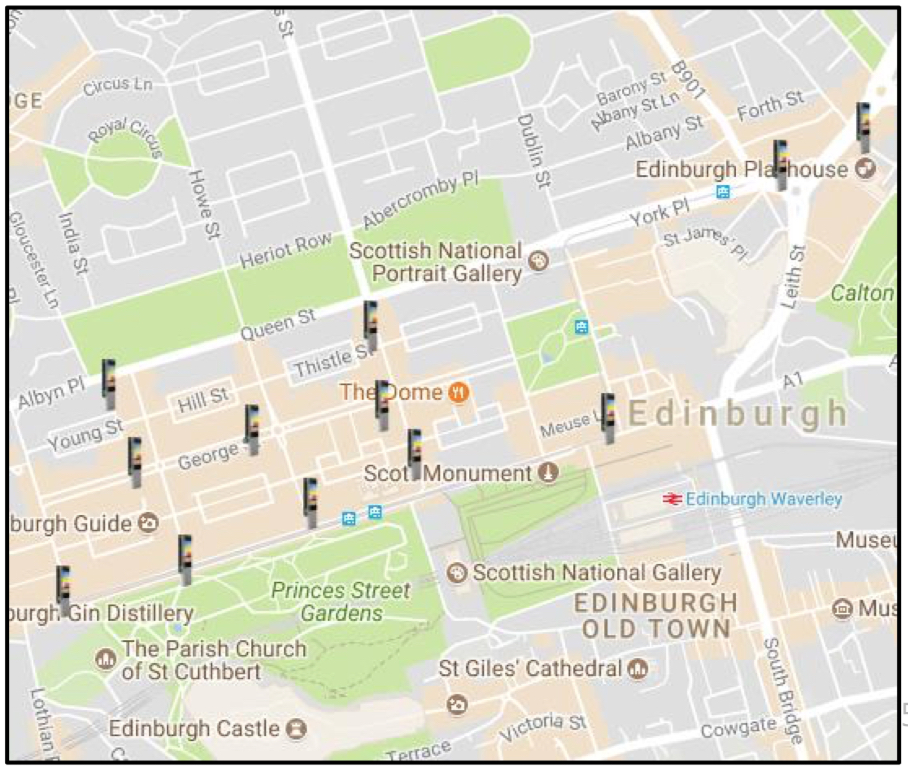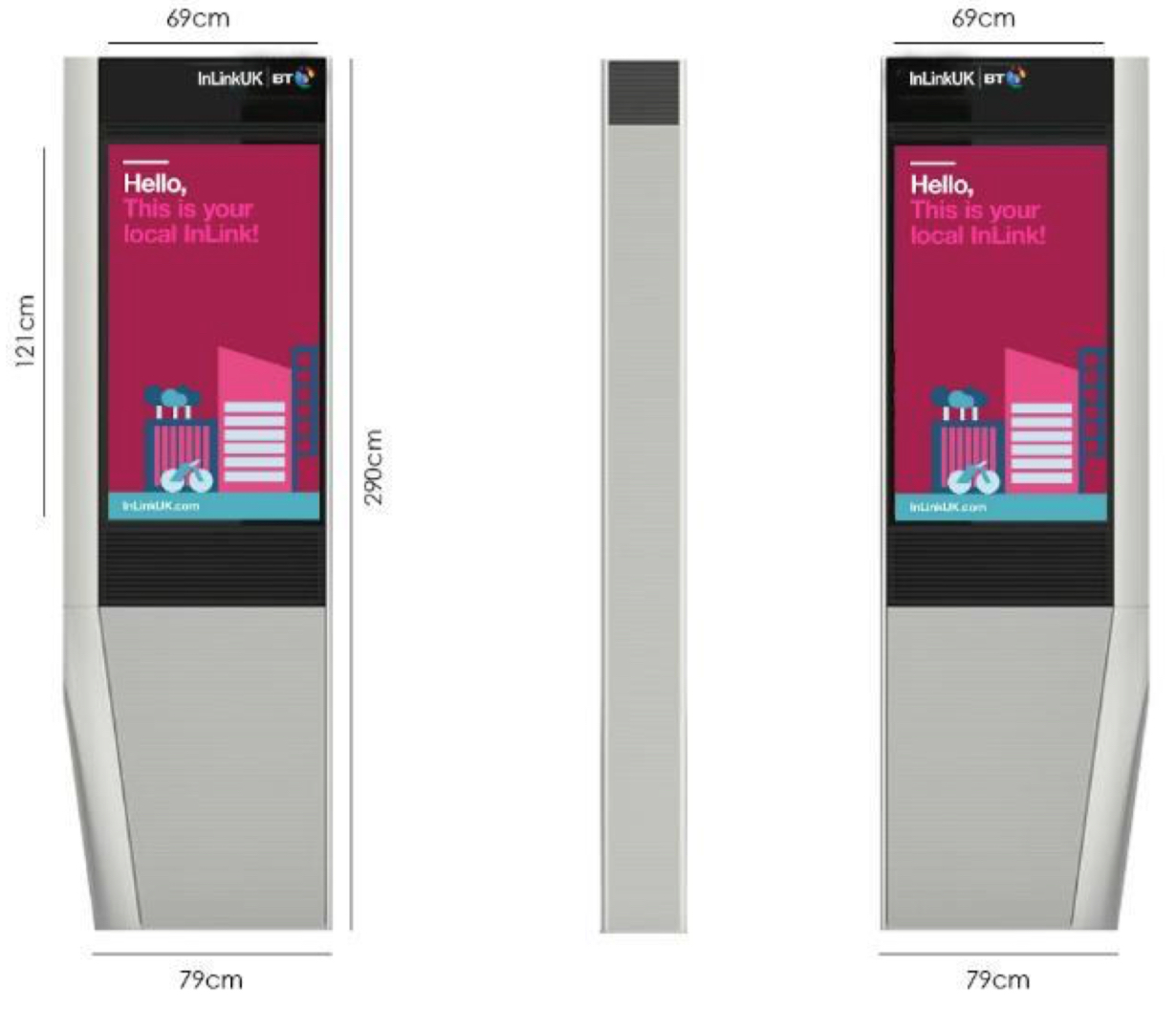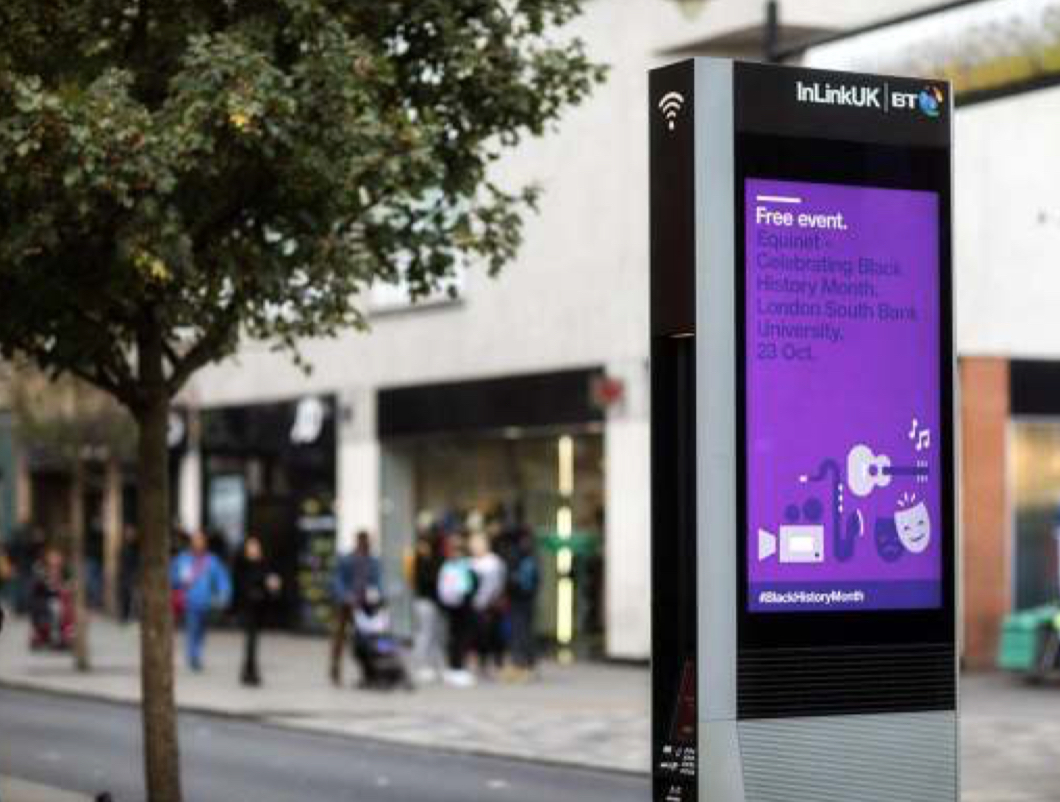
CAN EDINBURGH RESIST SIREN CALLS?
British Telecommunications PLC seeks planning permission to remove 26 payphones from central Edinburgh and replace them with 12 InLink units.
InLinks offer free superfast WiFi, mobile and landline calls, mobile-device charging, and access to maps, directories and local services.
All these free services are paid for by – you guessed it – illuminated, digital advertising panels integral to the units. If approved, there would be 24 of them across Castle, Frederick, George, Hanover, Queen, South St Andrew, and South Charlotte Streets, plus Baxter’s and Picardy Places.

Pros
InLinks are multi-purpose installations. Below, we quote from BT’s Design Statement:
- Free ultrafast Wi-Fi with speeds up to 1 Gb per second within 100m of each InLink, with more than 47,000 unique users having already subscribed, which as of last month saw them use enough data to view over 88 million webpages
- Touchscreen tablets to access council services, BT’s phone book, maps and directions, with more than 14,000 tablet sessions every week from our users
- Accessible in design including hearing induction loops, braille embossed and TalkBack functionality in the tablet for those with disabilities
- All InLinks are powered by 100% renewable energy with screens dimming at night
- The InLinkUK team provide bi-weekly cleaning and the ability to rapidly respond on an as-needed basis to any issues monitored by sensors in the InLinks
- With a footprint of just 0.22m2 InLinks are smaller than any comparable street furniture, and their installation also facilitates and funds the removal of two existing BT payphones giving back 1,78m2 for each installation
- So far [BT] have given back pavement space to local communities equivalent to install more than 70 street trees, 240 litter bins or 150 bicycle parks
- 438 hours of council content on the screens are provided to the Council on each InLink per year to promote local initiatives, news, and events
- Over 1,000 hours per year of hyper-local content allow each InLink to act as a community notice board with the InLinkUK team able to work with local groups to promote nearby events and activities
- Secure power-only USB ports for rapid device charging
- Free phone calls to UK mobile, local or national numbers, including the option to plug in your personal headphones for more privacy, with ~15,000 free calls made each week
- Direct 999 call button with location sharing and two-press approach to limit accidental activation, with emergency messaging capabilities currently under development
- The opportunity to integrate additional environmental sensors in collaboration including on air quality (under trial), noise, and other environmental factors.

Cons
InLinks are smaller, neater and technologically snazzier than the tatty old phoneboxes they are meant replace. But their digital advertising panels introduce an incongruous and (by purposeful design) distracting element into the Edinburgh World Heritage Site. They are not altruistic gifts to the city. They are commercially motivated visual clutter.
More generally, we wonder whether this part of Edinburgh really needs InLinks. The original payphones are under-used because so many people now have mobiles. They can charge these for free on Princes Street and in John Lewis, and those with smartphones already have access to the kind of services offered by InLinks wherever and whenever they wish.
JCDecaux, of course, tried something similar in 2016 (our website 27.10.16, 14.12.16) and was refused planning consent.
Logically, Edinburgh Planners should reject the new BT proposal for exactly the same reasons.

Grounds for objection
Despite all these devices’ capabilities, Spurtle sees no compelling reason for their introduction. Civilisation will not grind to a halt without them.
In our opinion, it would be a mistake to grant permission for the InLinks before City of Edinburgh Council has finished its considerations about improvement of George Street and the First New Town.
Spurtle did not spot detailed specification in the planning applications about how bright the advertising panels would be, or whether they would routinely display moving images. They will apparently dim at night, but we are concerned about how ‘attention-seeking’ they may be around the clock. City of Edinburgh Council should seek explicit assurances on these issues before reaching a decision.
Those readers wishing to resist the dubious charms of digital advertising here may wish to make material objections such as these, which have proved effective in the past:
- The introduction of the proposed digital advertisements into these visually sensitive locations would damage the unique and special historical character of Hanover and Frederick Streets.
- The proposals would be detrimental to the character and appearance of the New Town Conservation Area and World Heritage Site.
- The proposals would detract from long views views running across the New Town, and from the setting of and views to a number of listed buildings and structures.
- The proposals would be contrary to the Council’s Guidance on Advertisements, Sponsorship and City Dressing, the Guidance on Listed Buildings and Conservation Areas, the Edinburgh Design Guidance and the Street Design Guidance.
- The upgrade to LCD advertising, and the consequent increase in visual distraction, represents a material alteration in the manner of the current advertising space.
- The visual distraction to motorists, caused by digital advertising panels adjacent to roads, would negatively impact public safety.
- The proposals do not support the principles set out within the New Town Conservation Area Character Appraisal, The Edinburgh World Heritage Site Management Plan or the emerging vision and would introduce material changes to the First Town before the Council’s George Street and First New Town consultation and design process has run its course.
- The proposals would have an unacceptable impact on the amenity of the location, and would not accord with Regulation 4 (1) of the Town & Country Planning (Control of Advertisements) (Scotland) Regulations 1984 (as amended).
- The proposals would do harm to the historic environment, and the architectural and cultural interest of this part of the city in the New Town Conservation Area, Old and New Towns World Heritage Site, being in close proximity to a number of listed buildings.
Where and when
Anyone wishing to comment on the applications may do so by 18 May HERE. It is only necessary to write once, but you should include all the following reference numbers: 18/01303/FUL, 18/01304/ADV, 18/01305/FUL, 18/01306/ADV, 18/01307/FUL, 18/01308/ADV, 18/01310/FUL, 18/01311/ADV, 18/01312/FUL, 18/01313/ADV, 18/01317/LBC, 18/01320/FUL, 18/01321/ADV, 18/01322/FUL, 18/01323/ADV, 18/01325/FUL, 18/01326/ADV, 18/01327/FUL, 18/01329/ADV, 18/01334/FUL, 18/01335/ADV, 18/01336/FUL, 18/01337/ADV, 18/01338/FUL, 18/01339/ADV.
[The map and InLink images above have been extracted from documents submitted as part of the BT planning applications.]
Got a view? Tell us at spurtle@hotmail.co.uk and @theSpurtle and Facebook
------------

